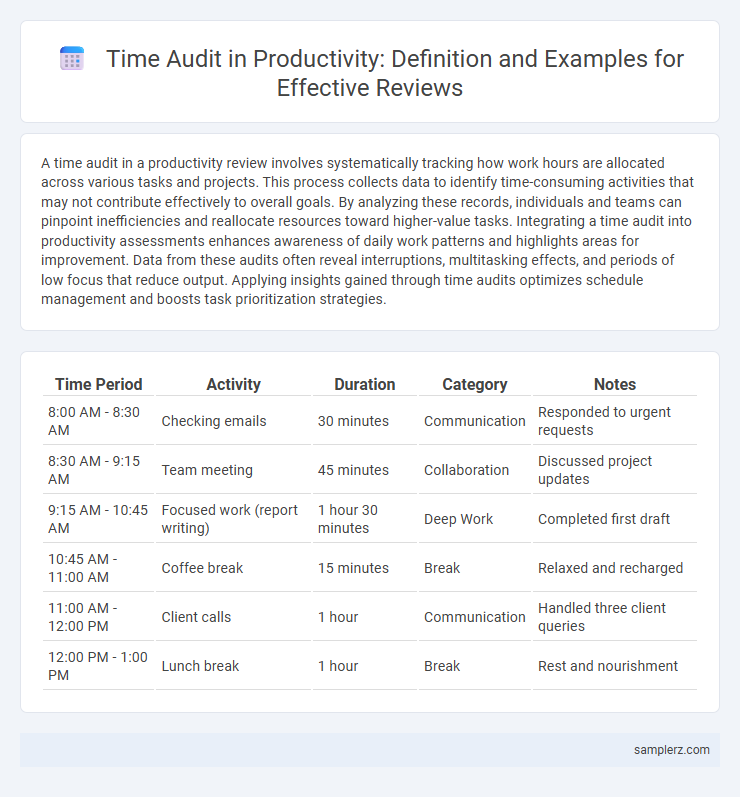A time audit in a productivity review involves systematically tracking how work hours are allocated across various tasks and projects. This process collects data to identify time-consuming activities that may not contribute effectively to overall goals. By analyzing these records, individuals and teams can pinpoint inefficiencies and reallocate resources toward higher-value tasks. Integrating a time audit into productivity assessments enhances awareness of daily work patterns and highlights areas for improvement. Data from these audits often reveal interruptions, multitasking effects, and periods of low focus that reduce output. Applying insights gained through time audits optimizes schedule management and boosts task prioritization strategies.
Table of Comparison
| Time Period | Activity | Duration | Category | Notes |
|---|---|---|---|---|
| 8:00 AM - 8:30 AM | Checking emails | 30 minutes | Communication | Responded to urgent requests |
| 8:30 AM - 9:15 AM | Team meeting | 45 minutes | Collaboration | Discussed project updates |
| 9:15 AM - 10:45 AM | Focused work (report writing) | 1 hour 30 minutes | Deep Work | Completed first draft |
| 10:45 AM - 11:00 AM | Coffee break | 15 minutes | Break | Relaxed and recharged |
| 11:00 AM - 12:00 PM | Client calls | 1 hour | Communication | Handled three client queries |
| 12:00 PM - 1:00 PM | Lunch break | 1 hour | Break | Rest and nourishment |
Understanding the Importance of a Time Audit
Conducting a time audit reveals precise allocation of hours across tasks, highlighting areas of inefficiency and hidden productivity drains. By systematically tracking activities, individuals gain insights into how their workday is structured, enabling data-driven adjustments to optimize focus on high-impact tasks. Understanding the importance of a time audit empowers professionals to eliminate time-wasting habits and maximize output by aligning efforts with strategic priorities.
Key Steps to Conducting a Time Audit
Identify and categorize daily activities by tracking time spent on tasks with tools like time-tracking apps or detailed logs. Analyze patterns to uncover inefficiencies and prioritize high-impact activities that align with productivity goals. Implement adjustments such as eliminating distractions, allocating specific time blocks, and setting clear deadlines to optimize time management and boost overall productivity.
Real-Life Examples of Time Audit Reports
A time audit report from a software development team revealed that daily stand-up meetings consumed 25% of productive hours, prompting a shift to bi-weekly check-ins that increased coding time by 15%. In another case, a marketing agency conducted a time audit showing that social media management absorbed 40% of workdays, leading to automation tools that saved 10 hours per week. These real-life examples demonstrate how data-driven time audits identify inefficiencies and enable strategic adjustments to boost overall productivity.
Common Patterns Identified in Time Audits
Time audits often reveal recurring patterns such as excessive multitasking, frequent interruptions, and prolonged periods spent on low-priority tasks. Identifying time blocks dominated by meetings or unstructured browsing can highlight opportunities for optimization. Recognizing these patterns enables individuals to restructure their schedules for enhanced productivity and task prioritization.
Tools and Templates for Effective Time Auditing
Time audits enhance productivity by using specialized tools and templates that track and categorize daily activities for precise analysis. Digital tools like Toggl and RescueTime automate data collection, while customizable templates in Excel or Google Sheets help visualize time allocation and identify inefficiencies. Implementing these resources streamlines the review process, enabling more accurate adjustments to improve time management strategies.
Analyzing Your Week: Sample Time Audit Breakdown
Analyzing your week through a sample time audit breakdown reveals how blocks of time are allocated between tasks such as meetings, email management, and focused work sessions. Tracking these activities helps identify patterns of productivity and highlight periods of distraction or low efficiency. This detailed review guides strategic adjustments to scheduling and prioritization for enhanced time management.
Lessons Learned from Personal Time Audit Experiences
Conducting a personal time audit reveals patterns of unproductive habits and highlights time-wasting activities that can be minimized. Lessons learned often include the importance of prioritizing high-impact tasks and setting boundaries to protect focus periods. This process enhances self-awareness and enables better allocation of time toward goal-oriented activities, improving overall productivity.
Identifying Time Wasters Through Audit Results
Analyzing time audit results reveals patterns of unproductive activities such as excessive social media use, frequent email checking, and unscheduled breaks. Identifying these time wasters enables targeted adjustments to daily routines, increasing focus and efficiency. Implementing strategies based on audit insights prevents productivity loss and optimizes work performance.
Turning Audit Insights into Actionable Changes
Time audits reveal specific patterns of unproductive habits, enabling targeted adjustments in daily schedules to maximize efficiency. By analyzing logged activities and durations, individuals identify time sinks and realign priorities toward high-impact tasks. Implementing changes such as blocking distractions and allocating focused work intervals translates audit insights into measurable productivity gains.
Measuring Productivity Gains After a Time Audit
Tracking time allocation during a detailed time audit provides concrete data to measure productivity gains by identifying inefficiencies and reallocating efforts to high-impact tasks. By comparing pre- and post-audit performance metrics such as task completion rates and output quality, organizations can quantify improvements and justify productivity-enhancing changes. Consistent monitoring of these key performance indicators after implementing audit-driven adjustments ensures long-term productivity optimization.

example of Time audit in review Infographic
 samplerz.com
samplerz.com